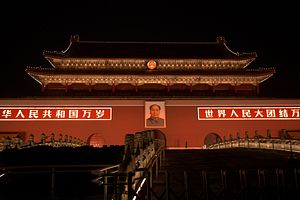Those perusing China’s reform plans can’t help but notice a certain date popping up with surprising frequency: 2020. A number of key goals, all seemingly unrelated, are pegged to this date. By 2020, leaders say, China will: achieve a 60 percent urbanization rate; complete construction on the Chinese space station; become an “Internet power”; place a cap on coal use and transition to clean energy; and even (according to unofficial reports) have its first domestically-built aircraft carrier. Perhaps most importantly, the Chinese Communist Party (CCP) has pledged that by 2020, China will be a “moderately well-off society” – meaning, in hard terms, that the per capita income in China will be double the 2010 figure. China will also attempt to double its current GDP in that same timeframe. That, in turn, is supposed to help China establish its international image and build up soft power.
What do these goals have in common, other than their projected completion date? They are all benchmarks of China becoming a prosperous, powerful, modern country. And that is exactly the accomplishment China wants to showcase at the 100th anniversary of the founding of the CCP, which will take place in 2021. Before then – in 2020, in other words – China’s government wants to have handfuls of concrete gains to show the people.
2021 marks the first of China’s “two centenary goals,” pegged to the 100th anniversaries of the CCP and the People’s Republic of China. These goals were put down in writing by the 18th Party Congress in 2012 – the same Party Congress that saw Xi Jinping assume the position of China’s top leader. Xi himself linked these goals to a catchier slogan: the “Chinese dream.” In Xi’s speeches, the “two centenary goals” are often paired with the “Chinese dream” or the “great rejuvenation of the Chinese nation” as twin aspirations. “At present, the Chinese people are striving to realize the Two Centenary Goals and the Chinese Dream of the rejuvenation of the Chinese nation,” Xi said in July 2014.
Linking the two concepts means that there is effectively a deadline for achieving the Chinese dream. By 2021, the “dream” must be at least partially complete. That in turn means that the CCP’s political legitimacy is closely tied to reaching its self-set benchmarks in 2020. Failing to reach these goals in time for the “first centenary” would call into question the CCP’s claim that only the Party can possibly lead China toward a prosperous future.
What’s intriguing about these 2020 goals, then, is that so many of them are objective. Even the subjective goal of creating a “moderately well-off society” has been given hard meaning by pegging it to China’s per capita income growth and GDP (which may, incidentally, be one reason China is not yet willing to back off from GDP growth targets). There’s no gray area involved — by 2020, either China will have a functioning space station and domestically-produced aircraft carrier or it won’t. That, in turn, indicates just how confident the CCP is that it can deliver on its promises and unveil all the trappings of a modern China by the beginning of 2021.
In the next five years, China will accelerate its progress in all the areas mentioned above — military, space and cyber technology, economic development, even environmental protection. Even Xi’s new foreign policy vision for China, what Zheng Wang calls China’s “alternative diplomacy,” is driven by a desire to get China more respect on the international stage, another crucial underpinning of the “Chinese dream” that will be evaluated in 2020. China’s “assertive” moves, whether in the South China Sea or in the Chinese technology market, should all be read against this backdrop: the CCP has a looming deadline for achieving China’s “rejuvenation.”
Of course, China will not be completely finished growing in 2020. For that, the world will have to wait for the second of China’s “centenary goals” to come around – 2049, the 100th anniversary of the founding of the People’s Republic of China. By that date, China’s leaders have pledged, China will be “a modern socialist country that is prosperous, strong, democratic, culturally advanced and harmonious.” Luckily for Xi Jinping, he won’t be the leader stuck dealing with that ambitious target.

































